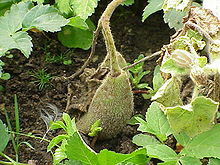
Commelinales is an order of flowering plants. It comprises five families: Commelinaceae, Haemodoraceae, Hanguanaceae, Philydraceae, and Pontederiaceae. All the families combined contain over 885 species in about 70 genera; the majority of species are in the Commelinaceae. Plants in the order share a number of synapomorphies that tie them together, such as a lack of mycorrhizal associations and tapetal raphides. Estimates differ as to when the Commelinales evolved, but most suggest an origin and diversification sometime during the mid- to late Cretaceous. Depending on the methods used, studies suggest a range of origin between 123 and 73 million years, with diversification occurring within the group 110 to 66 million years ago. The order's closest relatives are in the Zingiberales, which includes ginger, bananas, cardamom, and others.

The order Lamiales are an order in the asterid group of dicotyledonous flowering plants. It includes about 23,810 species, 1,059 genera, and is divided into about 25 families. These families include Acanthaceae, Bignoniaceae, Byblidaceae, Calceolariaceae, Carlemanniaceae, Gesneriaceae, Lamiaceae, Lentibulariaceae, Linderniaceae, Martyniaceae, Mazaceae, Oleaceae, Orobanchaceae, Paulowniaceae, Pedaliaceae, Peltantheraceae, Phrymaceae, Plantaginaceae, Plocospermataceae, Schlegeliaceae, Scrophulariaceae, Stilbaceae, Tetrachondraceae, Thomandersiaceae, Verbenaceae.

Canellales is the botanical name for an order of flowering plants, one of the four orders of the magnoliids. It is recognized by the most recent classification of flowering plants, the APG IV system. It is defined to contain two families: Canellaceae and Winteraceae, which comprise 136 species of fragrant trees and shrubs. The Canellaceae are found in tropical America and Africa, and the Winteraceae are part of the Antarctic flora. Although the order was defined based on phylogenetic studies, a number of possible synapomorphies have been suggested, relating to the pollen tube, the seeds, the thickness of the integument, and other aspects of the morphology.

The Santalales are an order of flowering plants with a cosmopolitan distribution, but heavily concentrated in tropical and subtropical regions. It derives its name from its type genus Santalum (sandalwood). Mistletoe is the common name for a number of parasitic plants within the order.

The Dilleniales are an order of flowering plants, potentially containing one family, Dilleniaceae. The APG III system of 2009, like the earlier APG II system of 2003, left the Dilleniaceae unplaced as to order, while noting that the name Dilleniales was available. Stevens at the Angiosperm Phylogeny Website has subsequently placed Dilleniaceae in the order Dilleniales.

Piperales is an order of flowering plants. It necessarily includes the family Piperaceae but other taxa have been included or disincluded variously over time. Well-known plants which may be included in this order include black pepper, kava, the many Peperomias, pepper elder, lizard's tail, birthwort, and wild ginger. The two perianthless families Piperaceae and Saururaceae are mainly herbaceous plants possessing highly reduced flowers.

Ranunculales is an order of flowering plants. Of necessity it contains the family Ranunculaceae, the buttercup family, because the name of the order is based on the name of a genus in that family. Ranunculales belongs to a paraphyletic group known as the basal eudicots. It is the most basal clade in this group; in other words, it is sister to the remaining eudicots. Widely known members include poppies, barberries, hellebores, and buttercups.

Austrobaileyales is an order of flowering plants consisting of about 100 species of woody plants growing as trees, shrubs and lianas. The best-known species is Illicium verum, commonly known as star anise. The order belongs to the group of basal angiosperms, the ANA grade, which diverged earlier from the remaining flowering plants. Austrobaileyales is sister to all remaining extant angiosperms outside the ANA grade.

Ceratophyllaceae is a cosmopolitan family of flowering plants including one living genus commonly found in ponds, marshes, and quiet streams in tropical and in temperate regions. It is the only extant family in the order Ceratophyllales. Species are commonly called coontails or hornworts, although hornwort is also used for unrelated plants of the division Anthocerotophyta.

The Aquifoliales are an order of flowering plants, including the Aquifoliaceae (holly) family, and also the Helwingiaceae and the Phyllonomaceae. In 2001, the families Stemonuraceae and Cardiopteridaceae were added to this order. This circumscription of Aquifoliales was recognized by the Angiosperm Phylogeny Group when they published the APG II system in 2003. In the Cronquist system, there is no Aquifoliales order: the Aquifoliaceae are placed within the order Celastrales and the others are in other families.

The Zygophyllales are an order of dicotyledonous plants, comprising the following two families:

The Buxales are a small order of eudicot flowering plants, recognized by the APG IV system of 2016. The order includes the family Buxaceae; the families Didymelaceae and Haptanthaceae may also be recognized or may be included in the Buxaceae. Many members of the order are evergreen shrubs or trees, although some are herbaceous perennials. They have separate "male" (staminate) and "female" (carpellate) flowers, mostly on the same plant. Some species are of economic importance either for the wood they produce or as ornamental plants.

Pedaliaceae, the pedalium family or sesame family, is a flowering plant family classified in the order Lamiales. The family includes sesame, the source of sesame seeds.

Saururaceae is a plant family comprising four genera and seven species of herbaceous flowering plants native to eastern and southern Asia and North America. The family has been recognised by most taxonomists, and is sometimes known as the "lizard's-tail family". The APG IV system assigned it to the order Piperales in the clade magnoliids.

In the APG IV system (2016) for the classification of flowering plants, the name asterids denotes a clade. Asterids is the largest group of flowering plants, with more than 80,000 species, about a third of the total flowering plant species. Well-known plants in this clade include the common daisy, forget-me-nots, nightshades, the common sunflower, petunias, yacon, morning glory, lettuce, sweet potato, coffee, lavender, lilac, olive, jasmine, honeysuckle, ash tree, teak, snapdragon, sesame, psyllium, garden sage, blueberries, table herbs such as mint, basil, and rosemary, and rainforest trees such as Brazil nut.

Schisandraceae is a family of flowering plants with 3 known genera and a total of 92 known species. Such a family has been recognized by most taxonomists, at least for the past several decades. Before that, the plants concerned were assigned to family Magnoliaceae and Illiciaceae.

Trimeniaceae is a family of flowering plants recognized by most taxonomists, at least for the past several decades. It is a small family of one genus, Trimenia, with eight known species of woody plants, bearing essential oils. The family is subtropical to tropical and found in Southeast Asia, eastern Australia and on several Pacific Islands.

Myrothamnus is a genus of flowering plants, consisting of two species of small xerophytic shrubs, in the southern parts of tropical Africa and in Madagascar. Myrothamnus is recognized as the only genus in the family Myrothamnaceae.

Huaceae is a family of plant in the rosids group, which has been classed in the orders Malpighiales, Malvales, and Violales or in its own order Huales. The APG II system placed it in the clade eurosids I, whereas the APG III system of 2009 and APG IV (2016) place it within the Oxalidales. The family is endemic to central Africa. It contains four species in the following two genera:

Icacinales is an order of flowering plants.




















